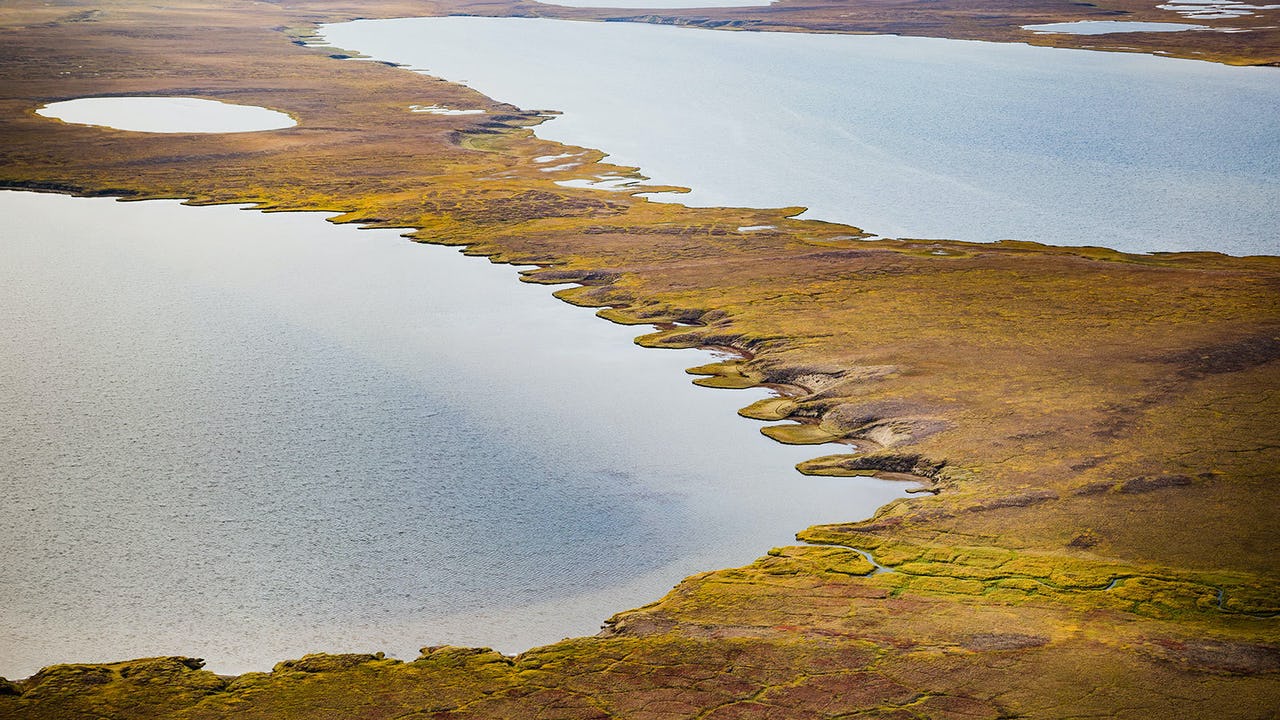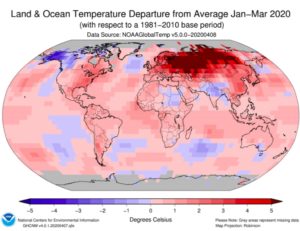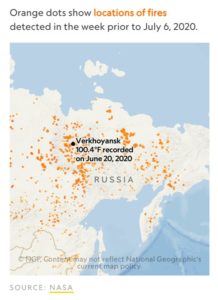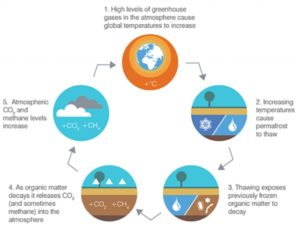The Global Carbon Budget and Permafrost Feedback Loops in the Arctic

Thermokarst lakes, like this one in Alaska, form in the Arctic when permafrost thaws. Photo: NASA/JPL-Caltech
Permafrost thaw is one of the world’s most pressing climate problems, already disrupting lifestyles, livelihoods, economies, and ecosystems in the north, and threatening to spill beyond the boundaries of the Arctic as our planet continues to warm. To examine the effects of permafrost degradation, and increase our understanding of what this phenomenon means for the future of the region (and the world), The Arctic Institute’s new two-part permafrost series aims to analyze the topic from scientific, security, legal, and personal perspectives. The second installment of our series features eight new articles on permafrost degradation and its effects on Arctic life, research, and the world at large. But before, check out the seven articles from our first installment, starting with the Intro.
The Arctic Institute Permafrost Series 2021
- Agents and the Arctic: The Case for Increased Use of Agent-Based Modeling to Study Permafrost
- Drunken Forests: Teaching About Permafrost Thaw Through Personal Experience
- The Global Carbon Budget and Permafrost Feedback Loops in the Arctic
- Meltdown – The Permafrost that Holds the Arctic Together is Falling Apart
- Reducing Individual Costs of Permafrost Thaw Damage in Canada’s Arctic
- North but Maybe Not North Enough: Adapting Sub-Arctic Communities and Infrastructure to a Changing Climate
- Climate Change and Geopolitics: Monitoring of a Thawing Permafrost
- Infrastructure and Community Resilience in the Changing Arctic: Status, Challenges, and Research Needs
- Permafrost Thaw in the Warming Arctic: Final Remarks
Siberia, like much of the world, had a year like no other. Stories about an unprecedented six-month heatwave and raging wildfires throughout Russia’s Northern regions filtered into the mainstream media. These alarming headlines reminded the world that climate change and its effects are being felt now, especially in the Far North. The Arctic, which is warming at least two times faster than the rest of the world, is a harbinger signaling dire consequences if we cannot keep global warming below 1.5 degrees Celsius.1) Hidden underneath these extreme events is a quieter but no less pressing threat that could prevent us from meeting that goal; one that may prove pivotal if we hope to curb global carbon emissions: thawing permafrost.
In order to be considered permafrost, the ground must remain at or below freezing for at least two consecutive years.2) It traditionally acts as a “carbon sink,” where carbon has been captured and stored. Scientists estimate that this layer contains approximately 1,400 gigatons of frozen carbon, the equivalent of four times the amount humans have emitted since the Industrial Revolution and two times as much as is currently contained in the environment.3) If this captured carbon were allowed to escape into the atmosphere, it would contribute to what may already be a runaway greenhouse effect that could render even the most ambitious attempts to cut global emissions ineffective. Essentially, we could make every necessary sacrifice and still see global temperatures rise above 1.5 degrees Celsius if the Arctic becomes a major carbon source instead of remaining a carbon sink. A recent NASA-funded study suggests that this shift is already happening due to winter soil emissions. According to Sue Natali of the Woods Hole Research Center, carbon emissions at individual sites are surpassing carbon uptake. It remains to be seen if this transition is occurring throughout the entire Arctic region. This development makes understanding and incorporating permafrost thaw emissions into the global carbon budget even more pressing.4)
Despite the potential ramifications of emissions from permafrost thaw, the global carbon budget, which balances the carbon dioxide (CO2) output from human activities with the input or storage in carbon sinks, does not fully incorporate this emission source.5) Ensuring that permafrost thaw is included in this calculation is critical in making our current goals reachable. Fortunately, the recent events in Siberia are bringing a new level of awareness to the leading role that permafrost will play in our future success or failure in staying below 1.5 degrees of warming. In examining these events, we can better understand the relationship between extreme weather, its impact on permafrost, and the consequences if the international community fails to account for this looming threat.
The six-month heatwave in Siberia contributed to raising the world’s average temperature to the hottest on record.6) From January through the end of June, Siberia was subjected to record high temperatures. One of the world’s coldest towns, Verkhoyansk, saw 100-degree days.7) According to Zeke Hausfather, the Director of Climate and Energy at the Breakthrough Institute in Oakland, California, Siberia’s temperatures were “extreme no matter how you look at them.”8). These temperatures concerned scientists because of their potential to increase the rate of thaw in the Arctic. High, prolonged temperatures melt more ice and snow, which expose the darker sub-layers. Without the layer of white snow and the protective albedo effect it provides, the soil begins to thaw. This, in turn, exposes more dark soil, which leads to further melting and so on. As the thaw moves deeper into the soil, nutrients are released, allowing plants and shrubs to grow, darkening the surface even more. As this positive, self-reinforcing feedback continues, more CO2 is emitted. Carbon dioxide is a significant contributor to global warming, resulting in more extreme weather and other climate events that amplify the cycle. Scientists fear that these local feedback loops will contribute to a global loop with disastrous, irreversible consequences. Unfortunately, high temperatures have also led to other devastating events in the Arctic.

In Siberia, these protracted, unusually high temperatures have resulted in conditions that have contributed to extreme wildfires. According to the National Aeronautics and Space Administration’s Earth Observatory, Siberia’s 2020 fire season released more carbon dioxide in June and July than any other fire season since 2003.9) These wildfires burn off the organic layers of moss and other decomposing plants that form on top of permafrost-affected soils. That organic matter typically acts as a blanket in the summertime to keep the darker, deeper soil insulated from the heat of the sun. However, the deeper layers of permafrost, having already thawed more than usual during the winter months from a reduced albedo effect, are now more susceptible to thaw in layers that would typically stay frozen even in the summer months. When wildfires burn off that summertime insulation, the initial loss of insulating materials kicks off a sequence of local feedback loops, amplifying permafrost thaw.10) Dr. Charles Koven, an Earth System Scientist for the University of California, Berkeley, notes that the permafrost research community’s ability to incorporate extreme events like wildfires into their climate models is limited. However, there is also a basic agreement that “there is a possibility that these extreme events are amplifying and speeding up things.”

There is a growing consensus among scientists and policymakers that this critical emissions source needs to be better represented in our climate models. Many in the permafrost research community, those who have been studying it and speaking up about it for years, worry that despite our best efforts and sacrifices, we may not be able to keep global warming below the goal of 1.5 degrees unless we consider these feedback loops. Dr. Koven estimates that about 100 gigatons of CO2 will need to be subtracted from the current global carbon budget to account for these emissions. While there is still significant uncertainty concerning the amount of CO2 held in permafrost, the impact of extreme events, and the rate of thaw, it is vital that the international community not ignore the situation until the models are improved. With permafrost thaw incorporated into the global carbon budget, policymakers will be better able to make decisions based on a more realistic picture of the actions countries will need to take to meet their carbon emission goals. Even so, including estimated emissions from permafrost thaw will just be the first step. Ongoing international cooperation will be essential in developing more effective observation networks and funding additional research in this critical area.
While the extreme events seen in Siberia last year seem ominous, they also present an opportunity. In recent years, scientists have seen more substantial interest in the Arctic generally and permafrost degradation in particular. With that may come more investment, international collaboration, and research that will be critical in reducing the current and future impact of permafrost thaw on the climate.
Erin Flanagan is a geopolitical analyst. The views expressed herein are those of the author and are not to be construed as official or reflecting the views of the Commandant or of the U.S. Coast Guard.
References
